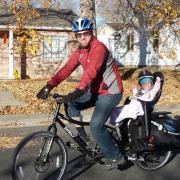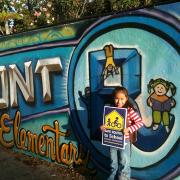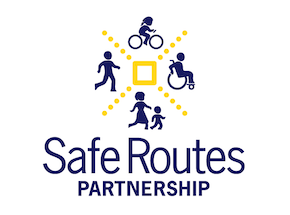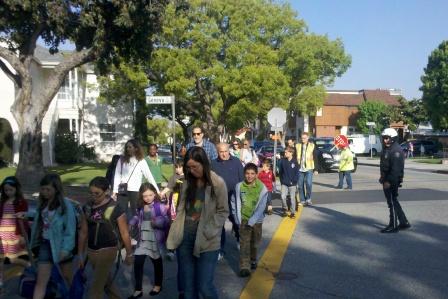Back in May, we asked you to take action against the US Department of Transportation’s (USDOT) proposed “system performance measures” that would have measured the speed of cars and trucks in seven different ways, while devoting no measures at all to people walking, bicycling, and taking transit.
Resource Library
Fired Up! That’s the best way I can describe the energy on the first day of the 3rd Safe Routes to School National Conference, which is being held at the Minneapolis Convention Center. About 600 people from nearly every state in the US came here seeking to learn, share and build connections so that they can go home with new tools to improve their communities, making them safer for kids to walk and bike – improving health, communities and the environment.
 With Congress in recess this week, we have a short breather. So I’m taking this opportunity to bring you up to speed on where things stand on the transportation bill. The past three weeks have been action-packed—and there’s more to come next week and beyond.
With Congress in recess this week, we have a short breather. So I’m taking this opportunity to bring you up to speed on where things stand on the transportation bill. The past three weeks have been action-packed—and there’s more to come next week and beyond.
 Hi, my name is Kathy Cooke, and I'm network coordinator for the Safe Routes Partnership! Even though I battle daily to get my two sons to put on a jacket or long pants during Portland's rainier months, I've found ways to make sure other "systems" are in place that help them get safely to and from school. We have tools at the ready to fix their bike brakes or pump air in their tires.
Hi, my name is Kathy Cooke, and I'm network coordinator for the Safe Routes Partnership! Even though I battle daily to get my two sons to put on a jacket or long pants during Portland's rainier months, I've found ways to make sure other "systems" are in place that help them get safely to and from school. We have tools at the ready to fix their bike brakes or pump air in their tires.
 Please note that the Request to Host for the 2013 Safe Routes to School National Conference was not released on April 16 as stated below. Stay tuned as we will send it out as soon as possible!
Please note that the Request to Host for the 2013 Safe Routes to School National Conference was not released on April 16 as stated below. Stay tuned as we will send it out as soon as possible!
 As I learn more about the communities in the Greater Washington, DC region, I am learning about the unique approaches and challenges to increasing walking and bicycling in each community. For example, some schools do not allow kids to walk or bicycle to school.
As I learn more about the communities in the Greater Washington, DC region, I am learning about the unique approaches and challenges to increasing walking and bicycling in each community. For example, some schools do not allow kids to walk or bicycle to school.
 From Bicycling Magazine to NPR's Talk of the Nation, the topic of Safe Routes to School is in the headings and creating a national conversation!
From Bicycling Magazine to NPR's Talk of the Nation, the topic of Safe Routes to School is in the headings and creating a national conversation!
 For the past two weeks veteran and budding bicyclists around the country have been peddling the joys of pedaling by participating in the National Bike Challenge , National Bike to S
For the past two weeks veteran and budding bicyclists around the country have been peddling the joys of pedaling by participating in the National Bike Challenge , National Bike to S
A Matter of the “Heart”
 Hi! Welcome to my blog.
Hi! Welcome to my blog.
 After several weeks of reports that Congressional conferees on the transportation bill were making progress, last week saw a flurry of news stories in the Capitol Hill trade press that negotiations are on the rocks. House Republicans from the Transportati
After several weeks of reports that Congressional conferees on the transportation bill were making progress, last week saw a flurry of news stories in the Capitol Hill trade press that negotiations are on the rocks. House Republicans from the Transportati
Wednesday, September 18, 2024 at 1 p.m. ET
Join us to learn about the fifth edition of Safe Routes Partnership’s state report cards and report, Making Strides: 2024 State Report Cards on Support for Walking, Bicycling, and Active Kids and Communities.
This report marks nearly a decade of work reviewing and scoring best practices in policy, funding and practices that support walking, biking, and active communities. We are excited to share the milestones and case studies that mark real progress during that time. During this webinar we will walk you through the scoring and indicators, the changes we have seen since our last state report cards in 2022, and how you can use this information to make change.
SPEAKERS:
- Kori Johnson, Program & Engagement Manager, Safe Routes Partnership
- Marisa Jones, Managing Director, Policy & Partnerships Director, Safe Routes Partnership
- Natasha Riveron, Policy & Implementation Manager, Safe Routes Partnership
 I love living in Southern California, especially the Los Angeles neighborhood I call
I love living in Southern California, especially the Los Angeles neighborhood I call
Parks play a role in supporting public health, from mitigating the impacts of climate change to reducing depression and anxiety. A 2022 systematic review by the Community Preventative Services Task Force – part of the U.S. Department of Health and Human Services and supported by the Centers for Disease Control – emphasized the importance of Safe Routes to Parks for maximizing the health benefits of parks, greenways, and trails. The findings, published in what is called the Community Guide, showed that rates of physical activity improved significantly only when parks were combined with at least one of four key strategies to facilitate their access and usage: community engagement, public awareness, structured programming, and access enhancements. So, why does this matter? It reinforces that Safe Routes to Parks is a research-backed strategy for improving health outcomes. For more information on this research and related strategies, check out: Actionable Public Health Strategies to Boost Community Well-Being with Safe Routes to Parks.

 How can we better promote walking and bicycling to school among girls? Studies show that the odds of walking and bicycling to school are 40 percent lower in girls than in boys (Giles-Corti et al, 2011;
How can we better promote walking and bicycling to school among girls? Studies show that the odds of walking and bicycling to school are 40 percent lower in girls than in boys (Giles-Corti et al, 2011;


THE TREE TRUNK
Muchas comunidades locales están ansiosas por utilizar fuentes de financiación del transporte para crear calles seguras para las personas que caminan y andan en bicicleta.



